Tropical forests in Africa don’t receive nearly as much attention as the Amazon rainforest or the jungles of southeast Asia, but that says nothing of their overall importance in the global carbon cycle.
New research has shown the highest mountain forests in Africa can store more carbon per hectare than even the Amazon – far more than we assumed they were capable of.
“The results are surprising because the climate in mountains would be expected to lead to low carbon forests,” says tropical forest ecologist Aida Cuni-Sanchez from the University of York in the United Kingdom and the Norwegian University of Life Sciences.
“The lower temperatures of mountains and the long periods they are covered by clouds should slow tree growth, while strong winds and steep unstable slopes might limit how big trees can get before they fall over and die.”
But Africa seems to have trees unlike any other continent. Even under harsh mountainous conditions, researchers found numerous trees growing over 70 centimeters in diameter (28 inches), storing just as much carbon as lowland forests elsewhere in Africa and also in Borneo.
Unfortunately, these same old-growth forests are the ones cut down for logging, mining, and farming operations and due to political unrest. Since the turn of the century, at least 0.8 million hectares of mountain forest have been lost, mostly in the Democratic Republic of the Congo, Uganda, and Ethiopia.
According to the calculations of researchers, that’s equivalent to emitting over 450 million tons of CO2 into the atmosphere.
And in the next decade, if we do nothing to curb deforestation, the African continent could lose 0.5 million hectares more.
“Better understanding of montane carbon stocks is important for many African countries, particularly in eastern Africa where montane forests represent most of the extant evergreen old-growth forest cover,” researchers write.
“Quantifying carbon stocks in these ecosystems is critical for estimating national carbon losses from deforestation and forest degradation. Quantifying carbon stocks in old-growth montane forests also serves to constrain potential carbon uptake by restored natural forests… “
And yet, to date, very little research has been done on the ability of African forests to store carbon. In fact, the authors say data from African mountain regions is “exceptionally sparse.”
For instance, a 2019 update to the 2006 Intergovernmental Panel on Climate Change (IPCC) report gave old-growth forests in the mountains of Africa the same carbon-storing potential as secondary forests in other high-altitude regions, roughly 89 tons of carbon per hectare.
But that could be a major underestimation. In the new study, when researchers analyzed old-growth forests in 44 mountain sites across a dozen African countries, they found a carbon-storing potential of 150 tons per hectare – nearly two-thirds more than the IPCC report.
That’s pretty much on par with lowland forests in Africa, and both landscapes had low stem density and a high abundance of larger trees. This suggests the higher altitude does not impact the structure and carbon storage of Africa’s forests nearly as much as other areas in the world.
Although the authors found some variation in carbon storage between mountain forests, the differences were not related to elevation.
In fact, the authors found the tropical mountain forests of Africa stored about 70 percent more carbon on average than other mountain forests elsewhere in the tropics.
“While we know what makes African forests special, we don’t yet know why they are different,” explains Cuni-Sanchez.
“It is possible that in Africa, the presence of large herbivores such as elephants plays an important role in mountain forest ecology, as these large animals disperse seeds and nutrients, and eat small trees creating space for others to grow larger, but this requires further investigation.”
Today, 14 African nations have committed themselves to the Bonn Challenge, which seeks to restore 350 million hectares of deforested land by 2030 to combat biodiversity loss, local poverty, and climate change.
The new results suggest we must preserve forests both high and low, right across the continent to achieve this lofty goal.
The study was published in Nature.



